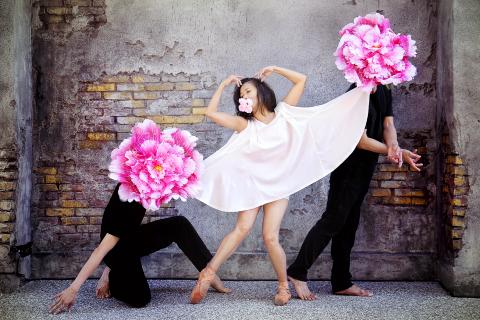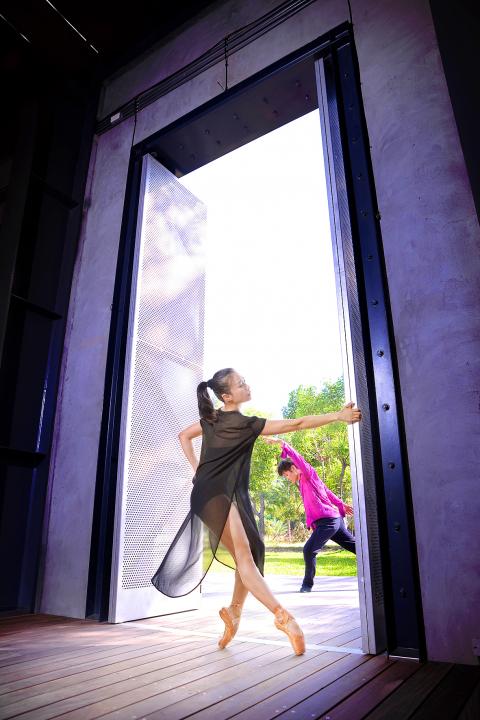Kaohsiung City Ballet (KCB, 高雄城市芭蕾舞團) founder Chang Hsiu-ru (張秀如) has an enviable record as a mentor and cultivator of both dancers and choreographers over her decades-long career, having marked 40 years as a dance teacher last year, while her company is now in its 23rd year.
She is bringing her best dancers to Taipei tomorrow for the start of the company’s annual Dance Shoe (點子鞋) production, with the three shows at the Experimental Theater at the start of a three-city tour.
The Dance Shoe productions are aimed at not only providing KCB members with more performing opportunities and the chance to dance under a variety of choreographers, but with giving choreographers born or working in southern Taiwan a platform for their creativity. It had done that and more. Since the first show in 2003, a total of 32 choreographers have created 71 works for the company.

Photo Courtesy of Kaohsiung City Ballet
Several now work with other troupes or have founded their own, such as former KCB dancer Yeh Ming-hwa (葉名樺), whose Nordic was performed at the Songshan Cultural and Creative Park at the beginning of last month, and who has been collaborating with Horse (驫舞劇場), and Benson Tsai (蔡博丞), whose created more than half-a-dozen works for Dance Shoe shows, founded his B.DANCE (丞舞製作團隊) in 2014 and last year picked up three choreography awards at dance festivals in Europe.
This year’s program features five works by choreographers that have been frequent contributors to previous editions. Wang Wei-ming (王維銘), a former Cloud Gate Dance Theatre (雲門舞集) dancer who teaches at Shu-Te University in Kaohsiung, and Wang Kuo-chuan (王國權), who spent 20 years working as a dancer in Europe before returning home, are probably the best known. The other three are Chang Ya-ting (張雅婷); Lai Hung-chung (賴翃中) and Dai Ting-ru (戴鼎如).
None of the pieces have been given “official” English titles, so the translations were worked out after some back and forth between the newspaper’s translation team and the company.

Photo Courtesy of Kaohsiung City Ballet
Wang Wei-ming’s piece The Stories They Told (她們在說故事) is set on five dancers and he said that he “stepped aside” in the creation of this piece, functioning more as an observer or co-author and letting the dancers have more of a hand in crafting the work.
Wang Kuo-chuan took Spanish flamenco as the starting point for his new work, Fragments of Madrid (馬德里的片段), a story about a wandering gypsy in which he will partner Ally Yeh (葉麗娟). He is the only choreographer who is also performing in the show.
Chang Ya-ting and Lai are both graduates of Taipei National University of the Arts (國立台北藝術大學) dance department, but their pieces show very different styles and outlooks.
Chang Ya-ting’s Murmurs (喃喃) features four dancers and two rather large flower heads. The piece was inspired by the way humans often mutter to themselves — about things they notice, questions they have or the way they are feelings — seemingly innocuous moments, but ones that are not forgotten and that sometimes bloom into something more consequential.
Lai’s duet for a man and a woman is entitled Grim Winter (凜凜) and centers on the emptiness and chill or winter and the hopes of the coming of spring.
Dai Ting-ru also created a duet, Waiting (從你的全世界路過), about life or the world passing a person by as they wait for something to happen.
After this weekend’s shows in Taipei, the company will return home to perform at the Kaohsiung Cultural Center’s Chihteh Hall next weekend and at the Tainan Municipal Cultural Center on Jan. 30.

The Lee (李) family migrated to Taiwan in trickles many decades ago. Born in Myanmar, they are ethnically Chinese and their first language is Yunnanese, from China’s Yunnan Province. Today, they run a cozy little restaurant in Taipei’s student stomping ground, near National Taiwan University (NTU), serving up a daily pre-selected menu that pays homage to their blended Yunnan-Burmese heritage, where lemongrass and curry leaves sit beside century egg and pickled woodear mushrooms. Wu Yun (巫雲) is more akin to a family home that has set up tables and chairs and welcomed strangers to cozy up and share a meal

Dec. 8 to Dec. 14 Chang-Lee Te-ho (張李德和) had her father’s words etched into stone as her personal motto: “Even as a woman, you should master at least one art.” She went on to excel in seven — classical poetry, lyrical poetry, calligraphy, painting, music, chess and embroidery — and was also a respected educator, charity organizer and provincial assemblywoman. Among her many monikers was “Poetry Mother” (詩媽). While her father Lee Chao-yuan’s (李昭元) phrasing reflected the social norms of the 1890s, it was relatively progressive for the time. He personally taught Chang-Lee the Chinese classics until she entered public

Last week writer Wei Lingling (魏玲靈) unloaded a remarkably conventional pro-China column in the Wall Street Journal (“From Bush’s Rebuke to Trump’s Whisper: Navigating a Geopolitical Flashpoint,” Dec 2, 2025). Wei alleged that in a phone call, US President Donald Trump advised Japanese Prime Minister Sanae Takaichi not to provoke the People’s Republic of China (PRC) over Taiwan. Wei’s claim was categorically denied by Japanese government sources. Trump’s call to Takaichi, Wei said, was just like the moment in 2003 when former US president George Bush stood next to former Chinese premier Wen Jia-bao (溫家寶) and criticized former president Chen

President William Lai (賴清德) has proposed a NT$1.25 trillion (US$40 billion) special eight-year budget that intends to bolster Taiwan’s national defense, with a “T-Dome” plan to create “an unassailable Taiwan, safeguarded by innovation and technology” as its centerpiece. This is an interesting test for the Chinese Nationalist Party (KMT), and how they handle it will likely provide some answers as to where the party currently stands. Naturally, the Lai administration and his Democratic Progressive Party (DPP) are for it, as are the Americans. The Chinese Communist Party (CCP) is not. The interests and agendas of those three are clear, but